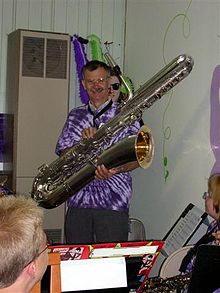Bass saxophone
 bass saxophone | |
| Woodwind instrument | |
|---|---|
| Classification | Single-reed |
| Hornbostel–Sachs classification | 422.212-71 (Single-reed aerophone with keys) |
| Inventor(s) | Adolphe Sax |
| Developed | 1840s |
| Playing range | |
 | |
| Related instruments | |
|
Sizes:
Orchestral saxophones: Specialty saxophones: | |
| Musicians | |
| See list of saxophonists | |
The bass saxophone is one of the lowest-pitched members of the saxophone family—larger and lower than the more common baritone saxophone. It was likely the first type of saxophone built by Adolphe Sax, as first observed by Berlioz in 1842.[1] It is a transposing instrument pitched in B♭, an octave below the tenor saxophone and a perfect fourth below the baritone saxophone. A bass saxophone in C, intended for orchestral use, was included in Adolphe Sax's patent, but few known examples were built. The bass saxophone is not a commonly used instrument, but it is heard on some 1920s jazz recordings, in free jazz, in saxophone choirs and sextets, and occasionally in concert bands and rock music.
Music for bass saxophone is written in

In jazz
The bass saxophone enjoyed some popularity in jazz combos and dance bands between World War I and World War II, primarily providing bass line, although bass sax players occasionally took melodic solos. Notable players of this era include Billy Fowler,
American bandleader
Some revivalist bass saxophonists performing today in the 1920s–1930s style are Vince Giordano and Bert Brandsma, leader of the Dixieland Crackerjacks. Jazz players using the instrument in a more contemporary style include Roscoe Mitchell, Anthony Braxton, Peter Brötzmann, J. D. Parran, Hamiet Bluiett, James Carter, Stefan Zeniuk, Michael Marcus, Vinny Golia, Joseph Jarman, Brian Landrus, Urs Leimgruber, Tony Bevan, and Scott Robinson, although none of these players use it as their primary instrument.
Jan Garbarek plays a bass sax on the 1973 album Red Lanta.
In rock
Bass saxophonists in rock include:
- Angelo Moore of the American band Fishbone
- Rodney Slater in the Bonzo Dog Doo-Dah Band (1960s)
- Ralph Carney of the avant-garde rock band Tin Huey (1970s)
- John Linnell of They Might Be Giants (formed 1982)
- Dana Colley of Morphine (formed 1989)
- Kurt McGettrick in Frank Zappa's band in the late 1980s
- Bob Seger and the Silver Bullet Bandoften played bass sax at live shows, in songs without a prominent sax part.
- Colin Stetson has performed and recorded with Arcade Fire, Bell Orchestre, Tom Waits, TV on the Radio, Bon Iver, Feist and LCD Soundsystem. He also performs and records his own compositions.
- Blaise Garza – touring member of Violent Femmes since 2004.
- Kellie Everett – member of The Hooten Hallers since 2014.
- Michael Wilbur - member of Moon Hooch
In classical music
At the 1844 World's Fair in Paris, the saxophone's premier performance was a chamber piece called Chant Sacré composed by Hector Berlioz for two trumpets, one soprano saxhorn, two clarinets, and one bass saxophone; Adolphe Sax himself played the saxophone part. The same year, Georges Kastner wrote for it in his opera Le Dernier Roi de Juda.
It is rarely used in
In the 1950s and 1960s it enjoyed a brief vogue in orchestrations for
The bass saxophone is occasionally called for in concert bands, typically in arrangements from before 1950. Australian composer Percy Grainger and American composer Warren Benson are particularly notable composers who wrote for it.
Today, bass saxophone is most commonly used to perform chamber music. It is typically featured in saxophone choirs and sextets, especially those in the direct legacy of teacher-soloist
References
- ISBN 978-0-300100-41-9.
- ^ "Six Brown Brothers". Redhotjazz.com. Archived from the original on 24 February 2015. Retrieved 19 May 2014.
- ^ "Stan Kenton Biography". Archived from the original on 4 March 2008. Retrieved 19 May 2014.
{{cite web}}: CS1 maint: bot: original URL status unknown (link)
External links
- BassSax.com web site
- Bass saxophone page at www.contrabass.com, the "Contrabass Mania" web site
- Innovative Bass Saxophone design from Eppelsheim
- Six Brown Brothers
- Vince Giordano plays bass saxophone on A Prairie Home Companion radio program, 9 April 2005
- MP3 excerpt of first movement of "Sonatina Giacosa" for bass saxophone and piano (1987) by Walter S. Hartley, performed by Jay Easton
- Dixieland Crackerjacks - Sweet Georgia Brown bass sax feature Watch Bert Brandsma in a bass saxophone feature: Sweet Georgia Brown, recorded April 28. 2007 (YouTube)
